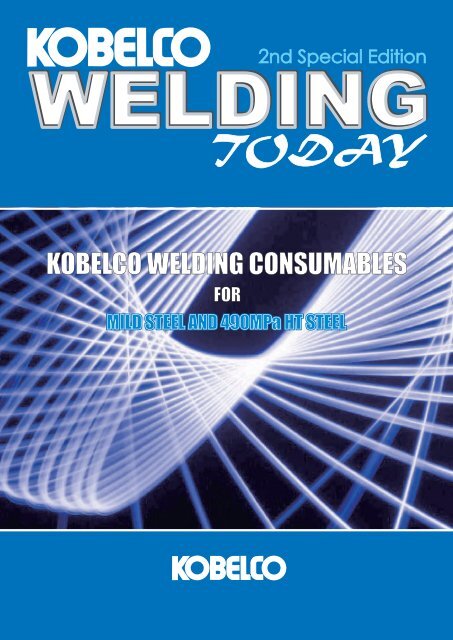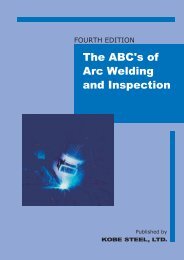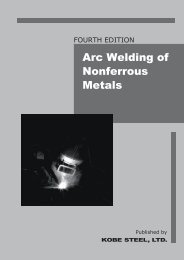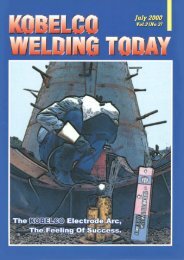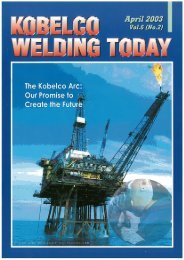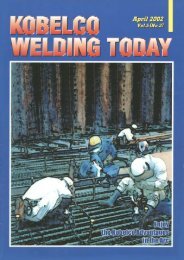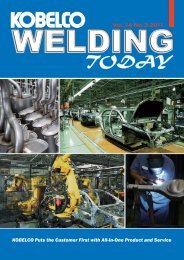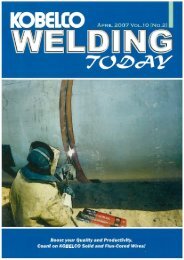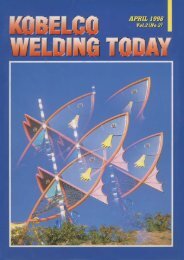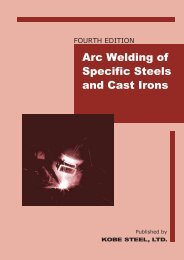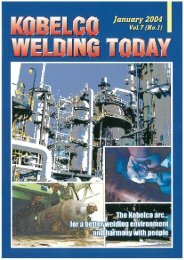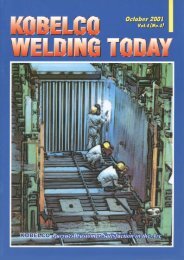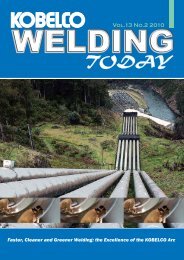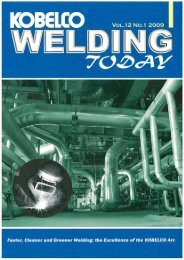KOBELCO WELDING CONSUMABLES
KOBELCO WELDING CONSUMABLES
KOBELCO WELDING CONSUMABLES
Create successful ePaper yourself
Turn your PDF publications into a flip-book with our unique Google optimized e-Paper software.
2nd Special Edition<br />
TODAY<br />
<strong>KOBELCO</strong> <strong>WELDING</strong> <strong>CONSUMABLES</strong><br />
FOR<br />
MILD STEEL AND 490MPa HT STEEL
PRODUCTS SPOTLIGHT<br />
<strong>KOBELCO</strong> <strong>WELDING</strong> TODAY<br />
A Quick Guide to Suitable Welding Consumables<br />
for Mild Steel and 490MPa High Tensile Strength Steel<br />
For Shielded Metal Arc Welding (SMAW)<br />
Applications<br />
Brand name*1<br />
AWS classification<br />
Features<br />
[F] RB-26 A5.1 E6013 Capable of vertical downward welding.<br />
[F] Z-44 A5.1 E6013 Lower fume emissions.<br />
Thin to medium plate joints<br />
[F] B-33 A5.1 E6013 Better bead appearance.<br />
[F] B-10 A5.1 E6019 Deeper penetration than E6013.<br />
[F] B-14 A5.1 E6019 Better X-ray soundness.<br />
[F] B-17 A5.1 E6019 Higher resistance to hot cracking.<br />
[F] LB-26 A5.1 E7016 For mild steel. Higher deposition rates.<br />
[F] LB-47 A5.1 E7016 For mild steel. Better X-ray soundness.<br />
[F] LB-52 A5.1 E7016 Typical electrode for 490MPa HT steel.<br />
[F] LB-M52 A5.1 E7016 Extra-low hydrogen. Harmless fumes.<br />
[F] LB-52A A5.1 E7016 Extra-low hydrogen. HIgher resistance to cold cracking.<br />
Thick plate joints<br />
[F] LB-52UL A5.1 E7016 Ultra-low hydrogen. Moisture resistant.<br />
[F] LB-57 A5.1 E7016 Suitable for 520MPa HT steel. Extra-low hydrogen.<br />
[F] LB-76 A5.5 E7016-G Suitable for 520MPa HT steel.<br />
[F] LB-52RC A5.1 E7016 Suitable for HIC resistant steel.<br />
[F] LB-52-18 A5.1 E7018 Higher deposition rates. Better usability with DCEP.<br />
[T] LB-7018-1 A5.1 E7018-1 Higher deposition rates. Excellent low-temp notch toughness.<br />
[F] LT-B52A A5.1 E7018 Typical electrode for 490MPa HT steel.<br />
Horizontal and flat fillets [F] KOBE-7024 A5.1 E7024 Suitable for manual and gravity welding.<br />
[F] LT-B50 - Non-low hydrogen. Not suitable for thick sections.<br />
[F] KOBE-6010 A5.1 E6010 Suitable for API grades of up to X52.<br />
[F] KOBE-7010S A5.5 E7010-P1 Suitable for API grades of X52-X60.<br />
Pipelines<br />
[F] KOBE-8010S A5.5 E8010-P1 Suitable for API grades of X60-X70.<br />
[F] LB-78VS A5.1 E7048 Extra-low hydrogen. Vertical downward welding.<br />
[F] LB-88VS A5.5 E8018-G Extra-low hydrogen. Vertical downward welding.<br />
[F] LB-98VS A5.5 E9018-G Extra-low hydrogen. Vertical downward welding.<br />
Root passes [F] LB-52U A5.1 E7016 Unsurpassed penetration bead appearance.<br />
Tacking [F] LB-52T A5.1 E7048 Excellent re-arcing with a low hydrogen coating.<br />
1. [F] designates FAMILIARC. [T] designates TRUSTARC.<br />
Tips for successful welding results<br />
1. This guidance is to help users select appropriate welding consumables. Users are requested to confirm whether the selected<br />
brand can satisfy the job requirements before use.<br />
2. Suitable electric polarity for SMAW electrodes are as follows: AC, DCEN or DCEP for EXX13, EXX19, and EXX24; AC or<br />
DCEP for EXX16, EXX18 and EXX48; DCEP for EXX10. Wires for FCAW and GMAW use DCEP (DW-A51B uses DCEN). For<br />
SAW flux-wire combinations, AC is recommended. Electric polarity can affect the usability of welding consumables and the<br />
chemical composition and mechanical properties of weld metals; therefore, it is recommended to confirm the performance of<br />
the consumable you selected, using the polarity of a power source available for a particular job.<br />
3. The trade designations with a prefix of G or MF are fused-type fluxes for SAW, whereas those that begin with PF are bondedtype<br />
fluxes. The trade designations shown with a prefix of DW or MX are flux-cored wires, whereas those denoted with a prefix<br />
of MG or MIX are solid wires. Shielding gas composition can affect the usability of a wire, the chemical composition and<br />
mechanical properties of the weld metal.<br />
4. The mechanical properties of weld metals can be affected by preheat and interpass temperatures and welding heat input.<br />
Therefore, these parameters must be controlled during welding to assure the weld quality.<br />
5. For details of individual brands, refer to <strong>KOBELCO</strong> <strong>WELDING</strong> HANDBOOK.<br />
1
PRODUCTS SPOTLIGHT<br />
<strong>KOBELCO</strong> <strong>WELDING</strong> TODAY<br />
For Flux Cored Arc Welding (FCAW)<br />
Applications<br />
Brand name*1<br />
AWS classification Features Shielding gas<br />
Thin plate joints [F] MX-100T A5.18 E70C-6C/6M Stable short-circuiting arc. Little slag. CO 2 or Ar+CO 2<br />
[F] DW-100 A5.20 E71T-1C Higher deposition rates in all position welding. CO2<br />
[F] DW-100V A5.20 E71T-1C Higher deposition rates in vertical-up welding. CO2<br />
Medium plate<br />
joints<br />
[F] DW-100E A5.20 E71T-9C Suitable for ship-class E-grade steels. CO2<br />
[F] DW-50 A5.20 E71T-1C/1M, 9C/9M Suitable for ship-class E-grade steels. CO 2 or Ar+CO 2<br />
[F] DW-A50 A5.20 E71T-1M Superior usability with low spatter. Ar+CO2<br />
[F] DW-A51B A5.20 E71T-5M-J Better crack resistance with DCEN. Basic-type flux. Ar+CO2<br />
Medium to thick<br />
plate joints<br />
[F] MX-100 A5.20 E70T-1C Higher deposition rates. Little slag. CO2<br />
[F] MX-A100 A5.18 E70C-6M Higher deposition rates. Little slag. Ar+CO 2<br />
[F] DW-200 A5.20 E70T-1C Larger legs. Better bead appearance and shape. CO2<br />
Horizontal and<br />
flat fillets<br />
[F] MX-200 A5.20 E70T-1C Higher resistance to inorganic zinc primer. CO2<br />
[F] MX-A200 A5.20 E70T-1M Higher resistance to inorganic zinc primer. Ar+CO2<br />
[F] MX-200E A5.20 E70T-9C Suitable for ship-class E-grade steels. CO 2<br />
1. [F] designates FAMILIARC.<br />
[F] MX-200H A5.20 E70T-1C Higher speeds on inorganic primer coated plates. CO 2<br />
For Gas Metal Arc Welding (GMAW)<br />
Applications<br />
Brand name*1<br />
AWS classification Features Shielding gas<br />
[F] MG-51T A5.18 ER70S-6 Stable short-circuiting arc. All-position welding. CO2 or Ar+CO2<br />
Thin to medium<br />
plate joints<br />
[F] MG-50T - Stable short-circuiting arc. All-position welding. CO2 or Ar+CO2<br />
[F] MIX-50 A5.18 ER70S-3 Stable arc with lower currents. Ar+CO 2<br />
[F] MIX-50S A5.18 ER70S-G Stable spray arc with higher currents. Ar+CO 2<br />
Thick plate<br />
joints<br />
[F] MG-50 A5.18 ER70S-G Stable arc with higher currents. CO2<br />
[F] MG-S50 A5.18 ER70S-G Superior usability and mechanical properties. Ar+CO2<br />
1. [F] designates FAMILIARC.<br />
For Gas Tungsten Arc Welding (GTAW)<br />
Applications<br />
Brand name*1<br />
AWS classification Features Shielding gas<br />
Thin to thick plate joints<br />
1. [F] designates FAMILIARC.<br />
For Submerged Arc Welding (SAW)<br />
[F] TG-S51T A5.18 ER70S-6 Superior properties after long time PWHT. Ar<br />
[F] TG-S50 A5.18 ER70S-G Suitable for Al-killed steels for low temp. Ar<br />
Root pass in pipe joints [F] NO65G A5.18 ER70S-2 More resistible to rusty surfaces. Ar<br />
Applications<br />
1. [F] designates FAMILIARC.<br />
Brand name*1<br />
AWS classification<br />
Features<br />
Thin plate joints [F] G-50 / [F] US-36 A5.17 F7A2-EH14 Suitable for high speed welding.<br />
Thin to medium plate joints<br />
Medium to thick plate joints<br />
[F] G-60 / [F] US-36 A5.17 F7A2-EH14 Suitable for high speed welding.<br />
[F] PF-H45 / [F] US-43 A5.17 F6A4-EL8 Suitable for single or 4-5 multi-pass welding.<br />
[F] G-80 / [F] US-36<br />
[F] MF-38 / [F] US-36<br />
[F] MF-300 / [F] US-36<br />
A5.17 F7A2-EH14<br />
F6P2-EH14<br />
A5.17 F7A6-EH14<br />
F7P6-EH14<br />
A5.17 F7A6-EH14<br />
F7P6-EH14<br />
Good performance in multi-pass welding.<br />
Better porosity resistance and X-ray soundness.<br />
Better slag detachability.<br />
[F] PF-H55E / [F] US-36 A5.17 F7A4-EH14 Double-sided two-pass or multi-pass welding.<br />
Horizontal and flat fillets [F] MF-53 / [F] US-36 A5.17 F7A0-EH14 Better bead appearance and slag detachability.<br />
2
PRODUCTS SPOTLIGHT<br />
<strong>KOBELCO</strong> <strong>WELDING</strong> TODAY<br />
<br />
<br />
An unsurpassed rutile flux-cored wire for mild steel<br />
and 490MPa high tensile strength steel, which is<br />
highly reputed for solid ultimate performance.<br />
Inception of DW-100<br />
DW-100 was developed for welding mild steel and<br />
490MPa high tensile strength steel and launched<br />
into the world of arc welding nearly 30 years ago.<br />
The prefix of the trade designation, DW, was<br />
coined from the words, Dual Wire, because the<br />
wire consists of steel sheath and cored flux. This<br />
development provided the momentum for shipbuilders<br />
and bridge constructors in particular to<br />
employ semiautomatic and automatic welding with<br />
DW-100 instead of shielded metal arc welding<br />
with covered electrodes. This is why DW-100 is<br />
called an epoch-making flux-cored wire.<br />
(2) Much less spattering improves the welding<br />
environment and reduce downtime for removing<br />
spatter on the weld — Figure 2.<br />
<br />
<br />
<br />
<br />
<br />
Figure 2: A comparison between DW-100 flux cored wire<br />
(FCW) and conventional solid wire (SW) on the amount of<br />
spatter in CO 2 gas arc welding.<br />
(3) Convenient self-peeling slag removal and<br />
glossy bead appearance reduce postweld<br />
cleaning time — Figure 3.<br />
Outstanding features<br />
The most remarkable features of DW-100 when<br />
used with CO 2 gas shielding are the following.<br />
(1) Adjusting once a certain proper welding current<br />
within a wide range of amperage and voltage<br />
for each size of wire shown in Figure 1,<br />
there is no need to re-adjust the current position<br />
by position in all-position welding.<br />
Figure 3: Convenient self-peeling slag removal and glossy<br />
bead appearance with DW-100 in horizontal fillet welding.<br />
(4) Regular bead profiles and smooth fusion with<br />
base metal — Figure 4.<br />
<br />
<br />
<br />
<br />
<br />
<br />
<br />
Figure 4: Regular bead appearance and smooth fusion with<br />
the base metal in horizontal fillet welding with DW-100.<br />
<br />
<br />
<br />
Figure 1: Proper ranges of welding current and arc voltage for<br />
each size of DW-100.<br />
(5) High deposition rates can save labor costs by<br />
reducing welding time — Figure 5.<br />
(6) Consistent mechanical properties of tensile<br />
strength and Charpy impact toughness of the<br />
weld metal — Table 1.<br />
3
PRODUCTS SPOTLIGHT<br />
<strong>KOBELCO</strong> <strong>WELDING</strong> TODAY<br />
<br />
<br />
<br />
<br />
<br />
<br />
<br />
<br />
<br />
<br />
<br />
<br />
<br />
<br />
<br />
<br />
<br />
A variety of applications<br />
Nowadays DW-100 is used in various applications<br />
in such industries as shipbuilding, architectural<br />
structures, machinery, and bridges. Due to excellent<br />
usability, even an inexperienced welder can<br />
use DW-100 with satisfactory results. This usability<br />
includes stable wire feeding and tracking onto<br />
welding lines. DW-100 continually earns a high<br />
reputation from users in worldwide markets<br />
because of the services supported by the slogan,<br />
“QTQ” (Quality Products, Technical Support, and<br />
Quick Delivery) launched by Kobe Steel and the<br />
Kobelco group companies.<br />
Figure 5: A comparison on deposition rates between DW-100<br />
(FCW), conventional solid wire (SW) and covered electrode<br />
(CE) — wire extension: 25 mm, shielding gas: CO 2 .<br />
Table 1: Typical chemical and mechanical properties of DW-<br />
100 weld metal tested per AWS A5.20<br />
C Si Mn P S<br />
0.05 0.45 1.35 0.013 0.009<br />
0.2% OS<br />
(MPa)<br />
TS<br />
(MPa)<br />
El<br />
(%)<br />
IV<br />
(J)<br />
510 570 30 –18°C: 85<br />
A leader of flux-cored wire<br />
Since DW-100 was launched into the market, production<br />
of flux-core wires has ever increased. This<br />
is because of ever increasing consumption of fluxcored<br />
wires not only in shipbuilders and bridge<br />
constructors but also in other various industries<br />
throughout the world. Nowadays annual production<br />
of flux-cored wires in Japan has reached over<br />
125,000 metric tons, accounting for about 35.5%<br />
as shown in Figure 6. Among flux-cored wires,<br />
DW-100 is one of the leaders.<br />
<br />
<br />
<br />
<br />
<br />
<br />
<br />
<br />
DW-100 shines in various applications in such industries as<br />
shipbuilding, architectural structures, bridges and machinery.<br />
New things in the traditional<br />
During these three decades, DW-100 has seen its<br />
features refined, and applications expanded. In<br />
order to maintain the outstanding features of DW-<br />
100, the quality control in production is the very<br />
matter Kobe Steel stresses. DW-100 is a traditional<br />
flux-cored wire, but, at the same time, highly<br />
advanced in that the quality of DW-100 has been<br />
maintained through advanced research and production<br />
engineering.<br />
<br />
<br />
<br />
<br />
» Reference «<br />
[1] Statistic News. Welding Technology, Vol. 56, 4/2008,<br />
Sanpo Publications Inc.<br />
Figure 6: Annual production ratios of welding consumables in<br />
Japan in 2007 (Developed with data from Ref. 1)<br />
4
PRODUCTS SPOTLIGHT<br />
<strong>KOBELCO</strong> <strong>WELDING</strong> TODAY<br />
<br />
<br />
speeds for porosity in fillet welding. It clearly<br />
shows that MX-200 is far more resistant to shop<br />
primer than conventional rutile-type flux-cored<br />
wire and solid wire at a wide range of welding<br />
speeds.<br />
MX-200 can release you from the headache of<br />
porosity in the fillet welding of shop-primer-paintcoated<br />
steel plates in horizontal and flat positions<br />
Basic characteristics<br />
MX-200 is a metal type flux cored wire suited for<br />
fillet welding of mild steel and 490 Mpa high tensile<br />
strength steel painted with shop primer. The M<br />
of the trade designation stands for Metal, while X<br />
reflects the expectation excellence. MX-200 was<br />
developed as an exclusive-use flux-cored wire for<br />
fillet welding in the horizontal and flat positions<br />
with CO2 gas shielding.<br />
<br />
<br />
<br />
<br />
<br />
<br />
<br />
<br />
<br />
<br />
<br />
<br />
<br />
<br />
<br />
<br />
<br />
How shop primer causes porosity<br />
Shop primer is a coat of paint applied to the surface<br />
of steel plates in order to protect them from<br />
rusting during a long fabrication period. Shop<br />
primer is often used in shipbuilding and bridge<br />
construction. Shop primer can be a predominant<br />
cause of porosity in fillet welds. Porosity is<br />
believed to occur because the arc heat decomposes<br />
shop primer into several gases and metallic vapors,<br />
which form pores in the weld metal. The degree of<br />
porosity depends on the type and coating thickness<br />
of the shop primer, the type of welding wire and<br />
welding parameters.<br />
Advantages characteristics<br />
A typical flux-cored wire can overcome the porosity<br />
problem caused by shop primer if the welding<br />
speed is reduced or if the shop primer is partly<br />
removed from where the fillet welds will be laid<br />
on.<br />
However, if you need to do fillet welding much<br />
more effectively, using higher welding speeds and<br />
without removing shop primer, you will encounter<br />
the porosity problem.<br />
<br />
<br />
Figure 1: The results of testing the porosity resistance of MX-<br />
200 in comparison with conventional rutile-type flux-cored<br />
wire and solid wire in the fillet welding of shop-primer coated<br />
steel plates.<br />
Besides better resistance to shop primer, MX-200<br />
provides the following advantages:<br />
(1) Glossy, smooth bead appearance due to thin,<br />
regular slag covering.<br />
(2) Regular bead profile at a wide range of welding<br />
speeds due to excellent fusion at the toe of the<br />
fillet weld.<br />
(3) Less spatters due to smooth droplet transfer.<br />
(4) Smaller leg length (approx. 4mm) can be made<br />
more easily due to a stable arc at lower amperage.<br />
Figure 2 shows an example of bead appearance<br />
and a cross sectional profile of a fillet weld using<br />
MX-200. It shows smooth, regular bead appearance<br />
and regular leg length with proper penetration<br />
at the root of the fillet weld.<br />
Figure 1 shows the results of testing different types<br />
of welding wires and a wide range of welding<br />
5
PRODUCTS SPOTLIGHT<br />
<strong>KOBELCO</strong> <strong>WELDING</strong> TODAY<br />
Figure 2: Bead appearance and cross-sectional macrograph of a fillet weld<br />
(MX-200, 1.2mmØ, 280Amp., 28-32volt, 50cm/min.)<br />
In addition to excellent resistance against shop<br />
primer and unsurpassed usability, MX-200 is wellsuited<br />
for high speed welding. Figure 3 shows the<br />
relationship between welding speed and leg length<br />
of fillet welds. You can determine the required<br />
welding speed for different leg lengths using this<br />
figure.<br />
MX-200 can be used in automatic welding as well<br />
as semi-automatic welding. Figure 4 shows an<br />
example of an automatic welding process in which<br />
a portable fillet-welding carriage and MX-200 are<br />
used in fillet welding of longitudinal components<br />
in shipbuilding.<br />
<br />
<br />
<br />
<br />
<br />
<br />
<br />
<br />
<br />
<br />
<br />
Figure 4: Fillet welding of longitudinal components by using a<br />
portable fillet welding carriage and MX-200 in shipbuilding<br />
(Photo courtesy of Tuneishi Shipyard, Japan).<br />
<br />
<br />
Figure 3: The relationship between welding speed and fillet<br />
leg length as a function of welding current.<br />
Kobe Steel is sure MX-200 will provide you with<br />
efficient fillet welding at higher welding speeds<br />
and with increased mechanization in your workshops.<br />
Suitable for automatic welding<br />
MX-200 persistently earns a good reputation<br />
among users in shipbuilding, bridge construction,<br />
machinery fabrication, railway-car fabrication,<br />
steel structure fabrication due to the outstanding<br />
features:<br />
(1) Excellent resistant to shop primer<br />
(2) Excellent usability<br />
(3) Excellent high speed weldability<br />
6
PRODUCTS SPOTLIGHT<br />
<strong>KOBELCO</strong> <strong>WELDING</strong> TODAY<br />
<br />
<br />
MX-100, the prototype of metal flux-cored wire,<br />
offers a softer arc, lower spatter, higher deposition<br />
rates, less slag, and more...<br />
<br />
<br />
<br />
<br />
<br />
<br />
<br />
<br />
<br />
<br />
<br />
<br />
<br />
<br />
<br />
Inception of MX-100<br />
MX-100 was developed in 1985 as a metal fluxcored<br />
wire for CO2 shielded butt and fillet welding<br />
in the flat and horizontal positions. With its high<br />
deposition rate, low spatter and less slag, this<br />
development greatly improved the welding performance<br />
in semi-automatic, automatic and robotic<br />
welding of steel structures, industrial machinery<br />
and construction machinery.<br />
Unsurpassed features<br />
MX-100 is an epochmaking<br />
metal flux-cored<br />
wire suitable for steel<br />
structures, industrial<br />
machinery and construction<br />
machinery.<br />
With the unique metal-rich cored flux, MX-100 is<br />
characterized by the following outstanding performance.<br />
(1) HIGH DEPOSITION RATE: 10-30% higher<br />
when compared with solid wire (Figure 1),<br />
which is beneficial to increase the welding<br />
speed and thus reduce the total welding cost as<br />
such.<br />
(2) LOW SPATTER EMISSION: about one-half<br />
as low as that with solid wire (Figure 2) due to<br />
better arc stability and softer arc, thereby<br />
reducing postweld cleaning work on the<br />
weldments and the nozzle of the welding torch.<br />
(3) LOW SLAG GENERATION: comparable to<br />
that with solid wire, which enables continuous<br />
multipass welding without removing slag on<br />
each pass in thick plates of up to 25mm.<br />
<br />
<br />
<br />
Figure 1: A comparison between MX-100 and conventional<br />
solid wire on deposition rate.<br />
<br />
<br />
<br />
<br />
<br />
<br />
<br />
<br />
<br />
<br />
<br />
<br />
<br />
<br />
<br />
<br />
<br />
Figure 2: A comparison of amounts of spatter deposited on<br />
the welding nozzle in robotic welding of one connection core<br />
(16t×350 sq. mm).<br />
(4) CONSISTENT CHEMICAL AND MECHAN-<br />
ICAL PROPERTIES: suitable for mild steel<br />
and 490MPa high tensile strength steel (Table<br />
1).<br />
Table 1: Typical chemical and mechanical properties of MX-<br />
100 weld metal tested per AWS A5.20.<br />
Filler metal<br />
MX-100<br />
AWS A5.20<br />
E70T-1C<br />
C% 0.06 0.12 max.<br />
Si% 0.62 0.90 max.<br />
Mn% 1.35 1.75 max.<br />
P% 0.014 0.03 max.<br />
S% 0.011 0.03 max.<br />
0.2% OS (MPa) 510 400 min.<br />
TS (MPa) 580 490 min.<br />
El (%) 30 22 min.<br />
IV (J) –18°C: 50 27 min.<br />
Shielding gas CO2 CO2<br />
Polarity DCEP DCEP<br />
7
PRODUCTS SPOTLIGHT<br />
<strong>KOBELCO</strong> <strong>WELDING</strong> TODAY<br />
<br />
<br />
MX-A100, a highly efficient metal-cored wire, offers<br />
high deposition rates and low spatter emissions in<br />
gas metal arc welding with an Ar-CO2 gas mixture<br />
shield in the flat and horizontal positions. Typical<br />
applications are butt and fillet welding of mild steel<br />
and 490 MPa high tensile strength steel in industrial<br />
machinery and chemical engineering machinery.<br />
Fundamental properties<br />
The AWS classification for MX-A100 is E70C-<br />
6M as per A5.18 (Specification for Carbon Steel<br />
Electrodes and Rods for Gas Shielded Arc Welding).<br />
This metal cored wire is intended for both<br />
single- and multiple-pass applications. It is characterized<br />
by a spray arc and excellent bead wash<br />
characteristics. The second designator 70 indicates<br />
the minimum tensile strength (70,000 psi or 483<br />
MPa) of the weld metal tested according to the<br />
A5.18 specification. The third designator C stands<br />
for “composite (including metal cored) wire.” The<br />
suffix 6 indicates the chemical composition of the<br />
weld metal produced by the wire. The final suffix<br />
M indicates the type of shielding gas (75-80%Ar/<br />
balance CO2) used for classification of the wire.<br />
MX-A100 is also classified as EN ISO 17632-A-T<br />
42 4 M M 3 H5 in accordance with the European<br />
Standard EN ISO 17632 (Tubular Cored Electrodes<br />
for Gas Shielded and Non-Gas Shielded<br />
Metal Arc Welding of Non-Alloyed and Fine-<br />
Grain Steels). “T” designates tubular cored electrodes,<br />
“42” is the code number associated with the<br />
tensile properties of the weld metal. The next “4”<br />
is also the code number related to the weld metal<br />
impact toughness. The first “M” indicates the type<br />
of cored flux: metal powder. The second “M” designates<br />
the type of shielding gas suitable for the<br />
wire: gas mixture. “3” is the code number for the<br />
proper welding positions: flat butt, flat fillet and<br />
horizontal fillet. “H5” designates the maximum<br />
diffusible hydrogen content of the weld metal: 5<br />
ml/100g.<br />
Table 1 shows the typical chemical composition<br />
and mechanical properties of MX-A100 weld<br />
metal tested in accordance with the AWS standard.<br />
Table 1: Typical chemical composition and mechanical properties<br />
of MX-A100 weld metal with 80%Ar+20%CO2<br />
C% Si% Mn% P% S%<br />
0.05 0.63 1.58 0.017 0.011<br />
0.2% OS<br />
(MPa)<br />
TS<br />
(MPa)<br />
El<br />
(%)<br />
IV (J)<br />
450 550 33 –40°C: 71<br />
High productivity welding<br />
MX-A100 runs with a stable and low spatter arc.<br />
The slag produced is of a very low level, similar to<br />
that from a solid wire, and thus inter-run slag<br />
removal is not necessary. Combined with a highly<br />
reliable arc start, these characteristics make MX-<br />
A100 an ideal choice for robotic or mechanized<br />
welding.<br />
As shown in Figures 1 and 2, this wire offers a<br />
wide range of welding currents and high deposition<br />
rates, providing high welding productivity.<br />
<br />
<br />
<br />
<br />
<br />
<br />
<br />
<br />
<br />
<br />
<br />
<br />
<br />
<br />
<br />
<br />
<br />
<br />
<br />
<br />
<br />
Figure 1: Recommended welding parameter ranges.<br />
<br />
<br />
<br />
<br />
<br />
<br />
<br />
<br />
<br />
<br />
<br />
<br />
<br />
<br />
<br />
<br />
<br />
<br />
<br />
<br />
Figure 2: Deposition rates as a function of welding current.<br />
8
PRODUCTS SPOTLIGHT<br />
<strong>KOBELCO</strong> <strong>WELDING</strong> TODAY<br />
<br />
<br />
The high performance metal cored wire MX-100T is<br />
an excellent choice for all-position welding of thin<br />
sections of mild steel and 490 MPa high tensile<br />
strength steel. It can use either a CO2 gas or an<br />
Ar+CO2 gas mixture for shielding. No more burnthrough<br />
with a wide tolerance of welding currents<br />
and speeds.<br />
More resistant to burn-through<br />
Burn-through, which results in a discontinuity in<br />
weldments, is caused when the current is too high<br />
and welding speed too slow. In burn-through, a<br />
molten metal drops to the opposite side of the<br />
groove through the root of the welding joint. Burnthrough<br />
is a common problem in sheet metal welding.<br />
In general, to solve this problem, the welder<br />
may have to use smaller-size wires with lower<br />
welding currents and higher welding speeds. However,<br />
higher welding speeds tend to cause an irregular<br />
weld profile. By contrast, as shown in Figure<br />
1, MX-100T allows to use higher welding currents<br />
or slower welding speeds than solid wires do,<br />
thereby resulting in superior weld bead appearance<br />
without burn-through.<br />
sheet metals (0.8-3.2 mm) by using the shortcircuiting<br />
droplet transfer mode. MX-100T can<br />
also use higher welding currents, covering a wide<br />
range of welding currents as shown in Figure 2.<br />
<br />
<br />
<br />
<br />
<br />
<br />
<br />
<br />
<br />
<br />
<br />
<br />
<br />
<br />
Figure 2: MX-100T features a wide welding parameter range<br />
covering those of 0.9- and 1.2-mm diameter solid wires.<br />
Superior bead profiles<br />
MX-100T offers smooth, regular bead profiles<br />
without undercut and overlap in all-position welding<br />
as shown in Figures 3 and 4.<br />
Figure 3: An MX-100T (1.2mmØ) lap fillet weld made on 2-<br />
mm thick steel sheets in horizontal welding (80 Amp.)<br />
<br />
<br />
<br />
<br />
<br />
<br />
<br />
<br />
<br />
<br />
<br />
<br />
<br />
<br />
<br />
<br />
Figure 1: A comparison between MX-100T and solid wires on<br />
the welding current and speed limits in terms of burn-through.<br />
Wider toleration of welding currents<br />
MX-100T offers excellent arc stability at the lower<br />
welding currents (50-150A) needed for welding<br />
In addition to sheet<br />
metal welding in the<br />
auto, railroad vehicle<br />
and electrical<br />
appliance industries,<br />
MX-100T provides<br />
superior weld profiles<br />
in the one-side<br />
root pass welding of<br />
pipe joints fixed in<br />
the horizontal position.<br />
Figure 4: An MX-100T (1.2mmØ)<br />
weld made on a 2-mm thick fillet<br />
joint in vertical downward welding<br />
with an 80 amp current.<br />
9
PRODUCTS SPOTLIGHT<br />
<strong>KOBELCO</strong> <strong>WELDING</strong> TODAY<br />
How to adjust weld penetration<br />
MG-51T: No.1 solid wire for gas metal arc welding in<br />
autos, motorcycles, containers and other sheet<br />
metal products. MG-51T uses either a CO2 or an<br />
Ar+CO2 gas mixture shield in all position welding.<br />
Steady short-circuiting at low currents<br />
Steady short-circuiting at low currents is the most<br />
valuable feature of MG-51T. If a general solid wire<br />
is used at low currents it may generate much spatter,<br />
undercut and irregular bead appearance due to<br />
unsteady short-circuiting in the molten metal transfer.<br />
In contrast, MG-51T offers low spatter and<br />
undercut generation with uniform bead appearance<br />
because of stable short-circuiting transfer of molten<br />
droplets between the tip of the wire and the<br />
molten pool. This outstanding feature is derived<br />
from the sophisticated design of chemical composition<br />
and consistent quality surface of MG-51T.<br />
How to create steady short-circuiting<br />
Selection of proper welding current and arc voltage<br />
is essential for creating a steady short<br />
circuiting arc, thereby facilitating all-position<br />
welding with MG-51T — Figure 1.<br />
Arc voltage (V)<br />
40<br />
30<br />
20<br />
10<br />
<br />
<br />
0.9mmφ<br />
1.2mmφ<br />
It is important to control weld penetration in welding<br />
sheet metals, because burn-through (excessive<br />
melt-through) often results in damaged welds.<br />
Although an excessive root opening and joint misalignment<br />
can also cause burn-through, an excessive<br />
welding current is more often the case. Figure<br />
2 shows how to control weld penetration in relation<br />
to welding currents.<br />
Weld penetration (mm)<br />
6<br />
5<br />
4<br />
3<br />
2<br />
1<br />
0<br />
Weld bead<br />
Base metal<br />
Weld penetration<br />
0.9mmφ<br />
1.2mmφ<br />
50 100 150 200 250 300 350<br />
Welding current (A)<br />
Figure 2: Weld penetration of MG-51T as a function of welding<br />
current with a short circuiting arc.<br />
Outstanding wire-feeding and<br />
seam-tracking for higher welding efficiency<br />
The smooth surface and consistent cast and helix<br />
of MG-51T wire provides steady wire-feeding<br />
through conduit liners and contact tips and enables<br />
exact seam-tracking along welding lines. This performance<br />
is good for decreasing downtime to<br />
improve welding efficiency in semi-automatic and<br />
automatic welding. Due to such benefits, MG-51T<br />
has seen the market expanded in the auto, motorcycle,<br />
container and other sheet metal industries.<br />
0<br />
100 200 300<br />
Welding current (A)<br />
Figure 1: Proper ranges of welding currents and arc voltages<br />
for MG-51T (0.9 and 1.2mmØ).<br />
MG-51T is one of the<br />
most popular solid wires<br />
in the motorcycle industry.<br />
10
PRODUCTS SPOTLIGHT<br />
<strong>KOBELCO</strong> <strong>WELDING</strong> TODAY<br />
MG-51T shines in auto parts fabrication<br />
Typical applications in auto parts for MG-51T are frame assembly, lower and upper arm, axle beam, axle<br />
housing, torque converter, impact beam, bumper reinforcement, suspension member (cross member),<br />
instrument panel reinforcement, and seat frame, as included in Figure 4.<br />
Seat frame<br />
Suspension member<br />
Seat rail<br />
Axle housing<br />
Radiator<br />
Instrument panel<br />
reinforcement<br />
Steering rod<br />
Rear suspension<br />
Bumper<br />
Wheel<br />
Lower arm<br />
Front suspension<br />
Frame<br />
assembly<br />
Torque converter<br />
Axle beam<br />
Exhaust<br />
system<br />
Trailing arm<br />
Manifold system<br />
Muffler system<br />
Arm<br />
Figure 4: Varieties of auto parts where gas metal arc welding is applied.<br />
(MG-51T is used for welding parts of mild steel and 490 MPa high tensile strength steel)<br />
11
PRODUCTS SPOTLIGHT<br />
<strong>KOBELCO</strong> <strong>WELDING</strong> TODAY<br />
<br />
<br />
RB-26 is the traditional and advanced covered electrode<br />
for all-position welding (including vertical<br />
downward position) of mild steel sheets.<br />
Inception of RB-26<br />
RB-26 is a high titania type covered electrode for<br />
welding mild steel. It was developed in 1951. The<br />
R in “RB” stands for rutile, which is the major<br />
ingredient in the coating flux, while “B” symbolizes<br />
a slag-shield covered electrode. “26” represents<br />
the 26th year of the Showa era of Japan,<br />
corresponding to 1951 when it was developed.<br />
Is RB-26 old-fashioned?<br />
You may believe that RB-26 is old-fashioned due<br />
to its inception. RB-26, however, is commonly<br />
used worldwide for welding light sheet metals and<br />
light-gauge formed steel in light-duty steel structures,<br />
and for surfacing thick-section welds to<br />
improve rough surfaces (the surface dressing technique).<br />
The consumption of RB-26 differs country<br />
by country. In Southeast Asia and the Middle East,<br />
RB-26 is one of the most commonly used, contemporary<br />
electrodes.<br />
RB-26 is superior to other E6013<br />
electrodes on performance<br />
RB-26 persistently earns a good reputation among<br />
users due to the following outstanding features in<br />
out-of-position welding including the verticaldown<br />
position:<br />
(1) Smoother arc transfer<br />
(2) Less spatter<br />
(3) Self-peeling slag removal (Figure 1)<br />
(4) Smoother bead surfaces with fine ripples<br />
(5) Excellent fusion with base metals provides a<br />
longer bead per one electrode — advantageous<br />
in welding sheet metals<br />
(6) Consistent chemical composition and mechanical<br />
properties (Table 1)<br />
Figure 1: Convenient self-peeling slag removal with RB-26<br />
assures a glossy bead appearance without postweld brushing.<br />
Table 1: Typical chemical and mechanical properties of RB-<br />
26 weld metal tested per AWS A5.1<br />
C% Si% Mn% P% S%<br />
0.08 0.30 0.37 0.012 0.010<br />
YP (MPa) TS (MPa) El (%)<br />
450 510 25<br />
How RB-26 is of international<br />
Kobe Steel has established a worldwide production<br />
and sales network in order to assure quicker delivery<br />
and technical services matching local demands<br />
for RB-26. This electrode is now mainly produced<br />
by Thai-Kobe Welding Co., Ltd. in Thailand in<br />
accordance with the Kobe Steel quality standard,<br />
and is sold not only in the Thai domestic market,<br />
but also exported to other countries including<br />
Saudi Arabia, Vietnam, and Singapore. RB-26,<br />
among all the various brands classified as E6013,<br />
has persistently earned high reputation for the<br />
quality, delivery and technical service in these<br />
international markets.<br />
Committed to quality and<br />
customer satisfaction<br />
The high quality of RB-26 produced in both Japan<br />
and overseas is approved and certified by the ship<br />
classification societies of Nippon Kaiji Kyokai<br />
(NK), American Bureau of Shipping (AB) and<br />
Lloyd's Resister of Shipping (LR) — Table 2.<br />
These approvals and certificates will be reliable to<br />
users on the quality of RB-26.<br />
Table 2: Ship classification approvals for RB-26<br />
AB LR NK<br />
2 2m KMW2<br />
12
PRODUCTS SPOTLIGHT<br />
<strong>KOBELCO</strong> <strong>WELDING</strong> TODAY<br />
Further, the emphasis on quality pervades the factories<br />
in Japan and overseas — with nearly all of<br />
our employees involved in quality control circles.<br />
To ensure RB-26 is defect-free, we inspect it piece<br />
by piece (Figure 2) and lot by lot of production by<br />
using Kobe Steel’s proprietary inspection processes<br />
and procedures (Figure 3).<br />
equipment (Figure 4) has strengthened the quality<br />
control activities to maintain the traditional high<br />
quality.<br />
Figure 4: Computerized system strengthens quality control<br />
activities (at Thai-Kobe Welding).<br />
To ensure customer satisfaction, the marketing<br />
staffs work closely with customers and end users,<br />
providing technical services that include training<br />
in welding techniques. Unsurpassed quality of RB-<br />
26 and customer satisfaction remain our highest<br />
priorities.<br />
Figure 2: To ensure the appearance quality of RB-26, electrodes<br />
are inspected piece by piece in accordance with Kobe<br />
Steel’s standard (at Thai-Kobe Welding).<br />
Something new in the traditional<br />
Since its inception, RB-26 has seen its features<br />
refined and its markets expanded. Kobe Steel pursues<br />
keen quality control in order to maintain the<br />
outstanding features of RB-26 produced in Japan<br />
and overseas. RB-26 is a traditional covered electrode,<br />
but, at the same time, highly advanced in<br />
that the quality of RB-26 has been maintained<br />
through advanced research and production engineering.<br />
Kobe Steel hopes RB-26 will be an indispensable<br />
electrode for your workshops.<br />
Figure 3: In order to ensure the quality of RB-26, the dimensions<br />
of the electrodes are inspected lot by lot by using Kobe<br />
Steel's proprietary inspection procedures (at Thai-Kobe Welding).<br />
In 1999, Thai-Kobe Welding became the first<br />
welding consumables manufacturer in Thailand to<br />
achieve JQA ISO 9002 certification for customer<br />
satisfaction. Further the latest precise inspection<br />
Water tanks with a thin section are often fabricated with RB-<br />
26 in Thailand.<br />
13
PRODUCTS SPOTLIGHT<br />
<strong>KOBELCO</strong> <strong>WELDING</strong> TODAY<br />
<br />
<br />
Excels in Melt-Through Root-Pass Welding<br />
LB-52U (E7016) is an unsurpassed covered electrode<br />
for melt-through root-pass welding, or onesided<br />
root pass welding with penetration beads.<br />
With LB-52U your welding will be easier and<br />
faster, and you will have confidence in the quality<br />
of your welds in any kind of pipe welding of mild<br />
steel and 490MPa high tensile strength steel.<br />
Described here are the characteristics that have<br />
made LB-52U the best for one-sided pipe welding.<br />
(1) EXCELLENT USABILITY IN ALL-POSI-<br />
TION <strong>WELDING</strong><br />
LB-52U features a very stable arc and low spatter<br />
over a wide range of welding currents. In particular,<br />
it really shines in the melt-through root-pass<br />
welding of horizontally fixed pipes due to the<br />
smooth, glossy penetration beads that protrude on<br />
the reverse side of the groove (Figure 1) and the<br />
wider tolerance of the root opening — an advantage<br />
in site welding.<br />
Table 1: Typical chemical and mechanical properties of LB-<br />
52U weld metal<br />
C% Si% Mn% P% S%<br />
0.07 0.55 1.05 0.011 0.006<br />
0.2% OS<br />
(MPa)<br />
TS<br />
(MPa)<br />
EL<br />
(%)<br />
IV<br />
(J)<br />
[H]d*1<br />
(ml/100g)<br />
480 560 31 –29°C: 80 3.5<br />
1. Diffusible hydrogen in the weld metal made in the welding atmosphere<br />
of 21°C × 10%RH (Gas-chromatographic method)<br />
(3) FIELD-PROVEN ELECTRODE IN WORLD-<br />
WIDE MARKETS<br />
The outstanding usability of LB-52U in the meltthrough<br />
root-pass welding of pipe joints has satisfied<br />
users around the world. LB-52U has been popular<br />
for a variety of piping jobs across Russia, Asia<br />
and the pacific region. Particularly in Russia, LB-<br />
52U, with its extraordinary reliability, has made a<br />
great contribution to the construction of long, oil<br />
and gas pipelines in freezing weather. Since 1982,<br />
more than 33,000 metric tons of LB-52U have<br />
been consumed in the construction of the Russian<br />
pipelines (Figure 2).<br />
Figure 1: The surface and macrosectional profiles of a penetration<br />
bead protruding on the reverse side of a single-Vgroove<br />
weld.<br />
(2) SUPERIOR CRACK RESISTANCE AND<br />
MECHANICAL PROPERTIES<br />
LB-52U offers superior crack resistibility due to a<br />
lower amount of diffusible hydrogen in the weld<br />
metal. In addition, it excels in mechanical properties,<br />
particularly in impact strength at low temperatures<br />
(Table 1). Therefore, it can be used for lowtemperature<br />
applications as well as moderate hightemperature<br />
applications.<br />
Figure 2: A pipeline-welding site in Russia where LB-52U is<br />
used for joining the girth joints in freezing weather.<br />
14
PRODUCTS SPOTLIGHT<br />
<strong>KOBELCO</strong> <strong>WELDING</strong> TODAY<br />
LB-52-18 is a low-hydrogen electrode with a high<br />
deposition rate for mild steel and 490 MPa high<br />
tensile steel. It is an excellent choice for a variety of<br />
applications.<br />
Inception of LB-52-18<br />
LB-52-18 was developed around 1962. “L” stands<br />
for low hydrogen, while “B” symbolizes a slagshielding<br />
covered electrode. “52” refers to the typical<br />
tensile strength of deposited metal at the time<br />
the electrode was developed. “1” shows that it can<br />
be used in all positions, while “8” is the designation<br />
for “iron powder, low hydrogen” as in the<br />
AWS E7018 specification.<br />
High deposition rate<br />
The deposition rate is the weight of metal deposited<br />
per unit of time. Typical deposition rates of<br />
LB-52-18 and an ordinary E7016 electrode, as a<br />
function of welding current, are shown in Figure 1.<br />
Clearly the deposition rates are dependent on<br />
welding current, and LB-52-18 provides approximately<br />
20% higher deposition rates when compared<br />
with the conventional E7016 electrode.<br />
<br />
<br />
<br />
<br />
<br />
<br />
<br />
<br />
<br />
<br />
<br />
<br />
<br />
The deposition rate is an important variable in<br />
welding economics. A higher deposition rate necessarily<br />
results in a faster welding speed or shorter<br />
time for welding a certain mass of groove. Shorter<br />
welding time can reduce labor costs. LB-52-18,<br />
therefore, can provide savings by up to 20% over<br />
ordinary E7016 electrodes when the costs for<br />
material and overhead are kept constant.<br />
Outstanding features<br />
The features that help LB-52-18 stand apart from<br />
ordinary E7018 electrodes are:<br />
(1) Superior welding performance with either<br />
DCEP or AC currents<br />
(2) Superior mechanical properties with consistent<br />
tensile strength and high impact toughness<br />
(Table 1)<br />
(3) Superior crack resistibility<br />
Table 1: Typical chemical and mechanical properties of LB-<br />
52-18 weld metal tested per AWS A5.1<br />
C% Si% Mn% P% S%<br />
0.07 0.59 0.97 0.013 0.007<br />
0.2% OS<br />
(MPa)<br />
TS<br />
(MPa)<br />
El<br />
(%)<br />
IV<br />
(J)<br />
Highly reputed for 45 years<br />
PWHT<br />
(°C x h)<br />
500 560 31 –29°C: 110 As weld<br />
420 520 32 –29°C: 140 620x1<br />
Since it was launched, LB-52-18 has seen its features<br />
refined and its markets expanded. Kobe Steel<br />
pursues keen quality control in order to maintain<br />
the excellency of LB-52-18 produced in Japan and<br />
overseas. The maintenance of quality is an important<br />
factor in the high reputation LB-52-18 has persistently<br />
earned in such diverse fields as<br />
machinery, steel structures, bridge construction<br />
and shipbuilding.<br />
<br />
<br />
<br />
<br />
Figure 1: A comparison between LB-52-18 and conventional<br />
E7016 electrode in terms of deposition rate.<br />
The high deposition rate with LB-52-18 is variable for the<br />
maintenance welding of heavy-duty machinery in crushing<br />
plants.<br />
15
PRODUCTS SPOTLIGHT<br />
<strong>KOBELCO</strong> <strong>WELDING</strong> TODAY<br />
The No.1 low-hydrogen type electrode for both mild<br />
steel and 490 MPa high tensile strength steel suited<br />
for almost limitless applications.<br />
Inception of LB-52<br />
LB-52 was developed around 1958. “L” stands for<br />
low hydrogen, while “B” symbolizes a slag-shielding<br />
covered electrode. “52” refers to the level of<br />
approximate tensile strength of the deposited metal<br />
when it was developed.<br />
Outstanding features<br />
The outstanding features of LB-52 among other<br />
E7016 electrodes are:<br />
(1) Excellent usability in out-of-position welding<br />
with better arc concentration, easier slag<br />
removal and smoother bead appearance<br />
(2) Excellent mechanical properties with consistent<br />
tensile strength and high impact toughness<br />
(3) Excellent X-ray soundness<br />
<br />
<br />
<br />
<br />
<br />
<br />
<br />
<br />
<br />
<br />
<br />
<br />
<br />
<br />
<br />
<br />
<br />
<br />
<br />
<br />
<br />
Figure 1: Charpy impact energy transition curves of LB-52<br />
weld metals in the as-welded and postweld heat treated contitions.<br />
Figure 1 shows the Charpy impact energy transition<br />
curves of LB-52 weld metals tested with<br />
2mm-V-notch specimens at a wide range of temperatures.<br />
Due to high impact toughness in both aswelded<br />
and postweld heat treated conditions, LB-<br />
52 is used for low-temperature applications down<br />
to –20°C, in addition to room temperature and elevated<br />
temperature applications. Table 1 shows the<br />
typical chemical and mechanical properties of LB-<br />
52 weld metal tested in accordance with AWS<br />
A5.1.<br />
Table 1: Typical chemical and mechanical properties of LB-52<br />
weld metal tested in accordance with AWS A5.1<br />
C% Si% Mn% P% S%<br />
0.08 0.60 0.94 0.011 0.006<br />
0.2% OS<br />
(MPa)<br />
TS<br />
(MPa)<br />
El<br />
(%)<br />
IV<br />
(J)<br />
Highly reputed for 50 years<br />
PWHT<br />
(°C x h)<br />
500 570 32 –29°C:120 As weld<br />
420 520 33 –29°C:150 620 x 1<br />
Since it was launched, LB-52 has seen its features<br />
refined and its markets expanded. Kobe Steel pursues<br />
keen quality control in order to maintain the<br />
outstanding features of LB-52 produced in Japan<br />
and overseas. The maintenance of quality is an<br />
important factor in persistently earning a high reputation<br />
for LB-52 in almost limitless applications<br />
in such various fields as pressure vessels, storage<br />
tanks, pipelines, machinery, offshore structures,<br />
ships, bridges, and steel structures. Kobe Steel is<br />
sure LB-52 will be a reliable electrode for your<br />
workshops.<br />
LB-52 shines in such applications as structures, pipes and<br />
vessels in the construction of chemical plants and oil refineries.<br />
16
PRODUCTS SPOTLIGHT<br />
<strong>KOBELCO</strong> <strong>WELDING</strong> TODAY<br />
<br />
<br />
B-14 is a versatile ilmenite type covered electrode<br />
for mild steel, offering unsurpassed usability and<br />
weldability in all-position butt and fillet welding and<br />
in welding sheet metals and medium-thick (up to 20<br />
mm) plates.<br />
A history of ilmenite type electrodes<br />
Kobe Steel developed, in 1942, an epoch-making<br />
ilmenite type covered electrode: “B-17,” which<br />
used ilmenite (a composition of iron oxide and titanium<br />
oxide) as the raw material for the major part<br />
of the coating flux. After a period of years, Kobe<br />
Steel developed other ilmenite type covered electrodes,<br />
B-10 and B-14, so as to satisfy the requirements<br />
of a variety of users.<br />
The consumption of ilmenite type covered electrodes<br />
increased sharply, particularly in the shipbuilding<br />
industry (Figure 1) as the construction of<br />
ships increased through the 1960s and 1970s. The<br />
annual production of ilmenite type covered electrodes<br />
in Japan increased year by year up to<br />
132,000 MT in 1973, comprising a major portion<br />
of the market for mild steel covered electrodes.<br />
However, starting in 1975, right after the first global<br />
oil crisis, ship construction began to dry up,<br />
after which the consumption of covered electrodes,<br />
including the ilmenite type, rapidly decreased.<br />
Since then this trend has accelerated, with covered<br />
electrodes being superseded by gas metal arc welding<br />
wires in order to save welding costs.<br />
But the consumption ratio of ilmenite type covered<br />
electrodes was kept high until recent years. In<br />
1995, the annual production of ilmenite type covered<br />
electrodes was approximately 17,000 MT,<br />
which was approximately 30% of all 56,000 MT of<br />
mild steel covered electrode produced in Japan.<br />
Ilmenite type covered electrodes classified as<br />
D4301 in the JIS standard have been also classified<br />
as E6019 (iron oxide, titania potassium type) in the<br />
AWS standard since 1991. This standardization<br />
per AWS is due to Kobe Steel’s active work in the<br />
Japan Welding Engineering Society and the American<br />
Welding Society.<br />
Nowadays, ilmenite type covered electrodes are<br />
used for welding general steel structures, pipes,<br />
and ships in Japan and overseas. Among these<br />
ilmenite type covered electrodes B-14 is one of the<br />
leading brands, which is produced by Kobe Steel<br />
and overseas subsidiary companies: TKW in Thailand,<br />
KWS in Singapore, and INTIWI in Indonesia.<br />
What characteristics highlight B-14<br />
Compared with conventional E6013 electrodes, B-<br />
14 features the following characteristics.<br />
(1) Suitable for welding heavy-duty structures due<br />
to superior X-ray soundness, higher ductility,<br />
higher notch toughness (Figure 2), deeper penetration<br />
(Figure 3), and consistent tensile properties<br />
(Table 1).<br />
(2) Suitable for welding thicker steel plates with a<br />
thickness of up to about 20 mm due to superior<br />
hot crack resistance.<br />
Figure 1: Ilmenite type electrodes shined in shipbuilding<br />
throughout the 1960s and 1970s due to excellent usability<br />
and weldability.<br />
(3) Higher welding efficiency due to longer unit<br />
electrode length and higher proper currents<br />
(Table 2).<br />
17
PRODUCTS SPOTLIGHT<br />
<strong>KOBELCO</strong> <strong>WELDING</strong> TODAY<br />
Absorbed impact energy (J)<br />
120<br />
100<br />
80<br />
60<br />
40<br />
20<br />
0<br />
B-14<br />
E6013<br />
-40 -20 0 +20<br />
Testing temperature (℃)<br />
Figure 2: Charpy impact test results of B-14 and conventional<br />
E6013 weld metals.<br />
Table 1: Typical mechanical properties of B-14 weld metal<br />
tested in accordance with AWS A5.1<br />
C% Si% Mn% P% S%<br />
0.10 0.10 0.43 0.015 0.007<br />
YP (MPa) TS (MPa) El (%) IV (J)<br />
410 460 32 –18°C: 82<br />
Table 2: A comparison between B-14 and E6013 covered<br />
electrodes on unit length and proper welding current ranges<br />
Trade<br />
desig.<br />
B-14<br />
Conv.<br />
E6013<br />
Size (mmØ) 3.2 4.0 5.0<br />
Electrode unit<br />
length (mm)<br />
Proper welding<br />
current in flat<br />
position (Amp.)<br />
Electrode unit<br />
length (mm)<br />
Proper welding<br />
current in flat<br />
position (Amp.)<br />
400 450 450<br />
85-140 130-190 180-260<br />
350 400 400<br />
60-125 105-170 150-220<br />
Tips for better weld results with B-14<br />
The electrode’s performance depends greatly on<br />
how it is used. In order to get the better welding<br />
results, the following key points should be noted.<br />
(1) Use B-14 with welding currents within the<br />
proper ranges, because excessive welding currents<br />
may degrade X-ray soundness, increase<br />
spatter, and cause undercut and irregular bead<br />
appearance.<br />
(2) Redry B-14 at 70-100°C for 30-60 minutes, if<br />
the electrode picked up excessive moisture.<br />
This is because excessive moisture in the coating<br />
may degrade electrode’s usability and<br />
cause the occurrence of pits in the weld metal.<br />
Figure 3: A comparison between B-14 and E6013 covered<br />
electrodes (4.0 mmØ,175 A) in fillet weld penetration; P1, P2,<br />
and P3 show sizes of penetration.<br />
(3) Avoid excessively high temperatures and long<br />
time in redrying B-14, because the excessive<br />
redrying may damage the coating, causing less<br />
penetration, poor X-ray soundness, and electrode<br />
burn.<br />
(4) Because B-14 is a non-low-hydrogen type electrode,<br />
medium to thick mild steel work should<br />
be preheated at an appropriated temperature<br />
and kept during welding at a proper interpass<br />
temperature.<br />
18
PRODUCTS SPOTLIGHT<br />
<strong>KOBELCO</strong> <strong>WELDING</strong> TODAY<br />
<br />
<br />
TG-S50 is a versatile TIG welding solid wire with<br />
excellent usability and mechanical properties used<br />
for mild steel, 490 MPa high tensile strength steel<br />
and low-temperature Al-killed steel. Users will also<br />
find the mechanical properties approved by the ship<br />
classification societies to be reliable.<br />
Basic characteristics<br />
TG-S50 is a solid wire designed specifically for<br />
TIG welding. It is classified as AWS A5.18<br />
ER70S-G. As seen in the classification the minimum<br />
tensile strength of the deposited metal is 70<br />
kilo-pound per square inch or 480 MPa. TG-S50<br />
uses the DCEN (DC Electrode Negative) polarity<br />
and pure argon gas for shielding.<br />
Excellent qualities<br />
(1) TG-S50 offers less slag generation and better<br />
fusion in the root pass welding of pipes in all<br />
positions, providing very smooth penetration<br />
beads with regular weld ripples. This usability<br />
is advantageous in the welding of process pipes<br />
(Figure 1) where stricter X-ray soundness is<br />
required.<br />
Tensile Strength (MPa)<br />
treatment) conditions. TG-S50 weld metal features<br />
high tensile strengths even after longhour<br />
PWHT as shown in Figure 2. This is why<br />
TG-S50 is suitable for multi-pass welding of<br />
pressure components with thick sections by<br />
using a mechanized welding process.<br />
600<br />
550<br />
500<br />
450<br />
Figure 2: Typical tensile strength of TG-S50 weld metal as a<br />
function of PWHT conditions.<br />
(3) TG-S50 provides a quite high level of absorbed<br />
energy in Charpy impact tests over a range of<br />
testing temperatures as shown in Figure 3. This<br />
is why TG-S50 is also used for low-temperature<br />
applications at down to –40°C.<br />
<br />
As Weld 625℃x1hr 625℃x4hr 625℃x8hr<br />
Postweld heat treatment<br />
<br />
<br />
<br />
<br />
<br />
<br />
<br />
<br />
<br />
Figure 1: TG-S50 is very advantageous in the root pass welding<br />
of the process piping in all positions due to unsurpassed<br />
usability.<br />
(2) TG-S50 offers consistent tensile strength in<br />
both as-welded and PWHT (postweld heat<br />
<br />
Figure 3: Charpy impact test results of TG-S50 weld metal in<br />
as-welded and PWHT conditions.<br />
19
PRODUCTS SPOTLIGHT<br />
<strong>KOBELCO</strong> <strong>WELDING</strong> TODAY<br />
<br />
<br />
TG-S51T resembles TG-S50 in terms of applications<br />
of mild steel, 490 MPa high tensile strength steel,<br />
and Al-killed steel for low temperature services but<br />
is superior in tensile strength under extended<br />
postweld heat treatment conditions.<br />
Fundamental properties<br />
TG-S51T is classified as ER70S-6 in accordance<br />
with AWS A5.18 (Specification for Carbon Steel<br />
Electrodes and Rods for Gas Shielded Arc Welding).<br />
The typical chemical composition of the wire<br />
and the typical mechanical properties of the weld<br />
metal are shown in Table 1 with the AWS requirements.<br />
The gas tungsten arc welding (GTAW) process<br />
may partly be used (e.g. for root pass welding) on<br />
thick-wall work such as pressure vessels and process<br />
pipes that are subject to postweld heat treatment<br />
(PWHT), although the major part of the<br />
welding joints in such equipment are welded generally<br />
by more efficient processes such as shielded<br />
metal arc welding (SMAW), submerged arc welding<br />
(SAW), and gas metal arc welding (GMAW).<br />
In addition, the pipe-to-nozzle joints on a thick,<br />
large pressure vessel may be welded by a mechanized<br />
GTAW for better quality and efficiency. In<br />
these cases, the PWHT may have to be conducted<br />
for long hours according to the thickness of the<br />
work: e.g. 4 hours for 100-mm thick work. When<br />
the work is too big to conduct PWHT at one time<br />
in a particular furnace, the PWHT should necessarily<br />
be conducted several times — thus the total<br />
PWHT hours for some weld joints may be 8 to 16<br />
depending on the number of PWHT times. This is<br />
why the GTAW weld metal may also be required<br />
to satisfy the mechanical properties after long-hour<br />
PWHT.<br />
Table 2 shows the typical mechanical properties of<br />
TG-S51T weld metal after long-hour PWHT. Figure<br />
1 illustrates the effects of PWHT temper<br />
parameter on 0.2% offset strength and tensile<br />
strength. Clearly, TG-S51T weld metal can satisfy<br />
490 MPa under an extended PWHT condition.<br />
Table 1 Typical chemical and mechanical properties of TG-<br />
S51T in comparison with the AWS requirements*1<br />
Filler wire<br />
TG-S51T<br />
AWS A5.18-2005<br />
ER70S-6<br />
C% 0.10 0.06-0.15<br />
Si% 0.89 0.80-1.15<br />
Mn% 1.56 1.40-1.85<br />
P% 0.010 0.025 max.<br />
S% 0.011 0.035 max.<br />
Cu% 0.23 0.50 max.<br />
0.2% OS (MPa) 510 400 min.<br />
TS (MPa) 610 480 min.<br />
El (%) 32 22 min.<br />
IV (J) –29°C: 210 27 min.<br />
1. Chemical compositions are for solid wire, and mechanical properties<br />
are for weld metal in the as-welded condition. Other chemical<br />
elements are specified — Ni, Cr, Mo: 0.15% max. each; V: 0.03%<br />
max. Cu% includes that of Cu-coating.<br />
Suitable for extended PWHT applications<br />
Table 2: Typical mechanical properties of TG-S51T weld<br />
metal after long-hour PWHT<br />
PWHT<br />
(°C × h)<br />
0.2% OS<br />
(MPa)<br />
TS<br />
(MPa)<br />
El<br />
(%)<br />
IV (J)<br />
at –30°C<br />
625 × 8 440 560 34 170<br />
625 × 24 420 550 35 160<br />
<br />
<br />
<br />
<br />
<br />
<br />
<br />
<br />
<br />
<br />
<br />
<br />
<br />
<br />
Figure 1: Tensile strength and 0.2% offset strength of TG-<br />
S51T weld metal as a function of temper parameter (T: PWHT<br />
temperature by Kelvin; t: PWHT hours).<br />
<br />
<br />
20
PRODUCTS SPOTLIGHT<br />
<strong>KOBELCO</strong> <strong>WELDING</strong> TODAY<br />
Key points in TIG welding of pipes<br />
The NO65G filler wire is the best choice when the<br />
AWS ER70S-2 classification is a must for your welding<br />
procedures for the root pass welding of pipe<br />
joints in particular.<br />
Basic characteristics<br />
NO65G is a TIG welding solid wire suitable for<br />
mild steel and 490 MPa high tensile strength steel.<br />
The classification, ER70S-2, contains the following<br />
useful information. The number 70 indicates<br />
the required minimum tensile strength as a multiple<br />
of 1000 psi (70,000 psi = 480 MPa) of the weld<br />
metal made using the wire in accordance with the<br />
welding conditions specified in AWS A5.18. The<br />
letter S designates a solid wire. The suffix 2 indicates<br />
the chemical composition of the wire.<br />
As shown in Table 1, NO65G contains small<br />
amounts of such deoxidizers as Al (aluminum), Ti<br />
(titanium) and Zr (zirconium) in addition to the<br />
common elements of C (carbon), Si (silicon) and<br />
Mn (manganese). Due to the added deoxidizers,<br />
NO65G can be more resistant against the rust<br />
formed on the surfaces of the welding groove. The<br />
rust should be removed as much as possible before<br />
welding to get better results.<br />
Table 1: Typical chemical and mechanical properties of<br />
NO65G tested in accordance with AWS A5.18*1<br />
C% Si% Mn% P% S% Cu% Al% Ti% Zr%<br />
0.04 0.54 1.25 0.007 0.014 0.25 0.07 0.08 0.04<br />
0.2%OS<br />
(MPa)<br />
<br />
<br />
TS<br />
(MPa)<br />
El<br />
(%)<br />
IV<br />
(J)<br />
PWHT<br />
(°C × h)<br />
560 620 28 –29°C: 200 As weld<br />
520 600 30 –29°C: 160 625 × 8<br />
(1) Use proper welding currents for each diameter<br />
of the wire: 60-90A for 1.6 mmØ, 80-110A for<br />
2.0 mmØ, and 100-130A for 2.4 mmØ.<br />
(2) Use proper flow rates of pure argon gas for<br />
torch shielding: 8-15 liter/min. when there is<br />
no apparent ambient wind. No back shielding<br />
is needed in root pass welding with the penetration<br />
beads, unless otherwise specified.<br />
(3) Remove such dirt attached on the surfaces of<br />
the groove as mill scale, rust, oil and grease,<br />
because it can cause porosity in the weld<br />
metal.<br />
(4) Control the weld penetration in the root of the<br />
groove by controlling the arc exposure spot or<br />
the torch placement and the torch oscillation<br />
width as shown in Figure 1.<br />
Penetration<br />
Torch<br />
placement<br />
Torch<br />
oscillation<br />
A: Excessive B: Proper C: Inadequate<br />
A: Too much<br />
forward<br />
A: Too<br />
narrow<br />
Figure 1: Penetration (top) relates to the torch placement<br />
(middle) and the torch oscillation width (bottom), respectively.<br />
(5) The weld crater should be terminated on the<br />
groove face to prevent the occurrence of a crater<br />
crack (Figure 2).<br />
Change the welding mode<br />
to crater treatment<br />
B: Proper C: Too much<br />
backward<br />
B: Proper<br />
Root pass welding direction<br />
A: Too<br />
wide<br />
1. Chemical compositions are for solid wire, and mechanical properties<br />
are for weld metal. Copper includes that of Cu-coating. Electric<br />
polarity is DCEN. Shielding gas is pure Ar gas.<br />
Turn the crater onto the groove face<br />
to terminate<br />
Figure 2: Proper crater treatment to prevent a crater crack.<br />
21
PRODUCTS SPOTLIGHT<br />
<strong>KOBELCO</strong> <strong>WELDING</strong> TODAY<br />
MF-38/US-36 is a versatile filler metal combination<br />
of fused flux and solid wire for submerged arc welding<br />
(SAW) of butt and fillet joints in ships, industrial<br />
machinery, vessels, steel frames, and bridges.<br />
Basic properties<br />
MF-38 is a fused type flux classified as F7A6-<br />
EH14 and F7P6-EH14 when combined with US-<br />
36 solid wire classified as EH-14 in accordance<br />
with AWS A5.17 (Specification for Carbon Steel<br />
Electrodes and Fluxes for Submerged Arc Welding).<br />
According to the classification system each<br />
designator is given for the particular information<br />
as follows: “F” for virgin flux, “7” for the minimum<br />
tensile strength of weld metal (70,000 psi or<br />
480 MPa), “A” for as-welded condition, “P” for<br />
postweld heat treated condition, “6” for the Charpy<br />
impact testing temperature of –60°F (–51°C), “E”<br />
for electrode, “H” for high manganese content, and<br />
“14” for the nominal carbon content of wire<br />
(0.14%). Table 1 shows the typical chemical and<br />
mechanical properties of MF-38/US-36 tested as<br />
per AWS A5.17.<br />
Table 1: Typical chemical and mechanical properties of MF-<br />
38/US-36 tested in accordance with AWS A5.17*1<br />
Wire<br />
Weld metal<br />
<br />
<br />
C% Si% Mn% P% S% Cu%<br />
0.12 0.03 1.95 0.013 0.005 0.11<br />
C% Si% Mn% P% S% Cu%<br />
0.09 0.32 1.63 0.018 0.011 -<br />
0.2% OS<br />
(MPa)<br />
TS<br />
(MPa)<br />
1. Welding current: AC<br />
El<br />
(%)<br />
IV<br />
(J)<br />
Outstanding features<br />
PWHT<br />
(°C × h)<br />
490 570 30 –51°C: 59 As weld<br />
420 530 31 –51°C: 64 620 × 1<br />
MF-38/US-36 is more resistible to the rust and dirt<br />
of the base metal and thus offers excellent porosity<br />
resistance and X-ray soundness. The mechanical<br />
properties of multiple pass welds are consistent<br />
with approvals of ship classification societies as<br />
shown in Table 2. Figure 1 shows typical Charpy<br />
impact test results of the multi-pass weld metals.<br />
Table 2: Approvals of ship classification societies*1<br />
AB LR NV BV NK Others<br />
2T,2YT<br />
3M,3YM<br />
1. AB: American Bureau of Shipping; LR: Lloyd's Register of Shipping;<br />
NV: Det Norske Veritas; BV: Bureau Veritas; NK: Nippon Kaiji<br />
Kyokai; GL: Germanischer Lloyd; CR: Central Research of Ships<br />
S.A.; KR: Korean Register of Shipping.<br />
<br />
<br />
<br />
<br />
<br />
<br />
2T,2YT<br />
3YM<br />
Ⅱ YT<br />
( Ⅲ YM)<br />
<br />
<br />
A2,2YT<br />
A3,3YM<br />
KAW52T<br />
KAW53M<br />
<br />
<br />
<br />
Figure 1: Consistent results in Charpy impact testing of MF-<br />
38/US-36 multi-pass weld metal (Welding current: AC).<br />
Tips for successful welding results<br />
GL,CR<br />
KR<br />
(1) MF-38 has varieties of flux mesh sizes: 12×65,<br />
20×200, and 20×D. The proper flux size should<br />
be selected according to welding current to be<br />
used for better usability. In general, coarse particle<br />
flux uses lower currents and fine particle<br />
flux is suitable for higher currents: 12×65 for<br />
600A max., 20×200 for 600-1000A, and 20×D<br />
for 800A or higher. The most appropriate size<br />
of US-36 should be selected from among 1.6,<br />
2.0, 2.4, 3.2, 4.0, 4.8, and 6.4mm according to<br />
the thickness of the work and welding current<br />
to be used.<br />
(2) MF-38 is a fused flux with glassy appearance<br />
and thus is more resistible to moisture pick up.<br />
However, the flux should be redried before use<br />
by 150-350°C for 60 minutes to remove deposited<br />
moisture on the surfaces of the flux particles,<br />
thereby preventing welding defects.<br />
22
THE WORLDWIDE MANUFACTURER<br />
GLOBAL MANUFACTURING AND SALES BASES<br />
ASIA<br />
ASIA<br />
JAPAN:<br />
KOBE STEEL, LTD., Welding Business<br />
Marketing Dept., International Sales & Marketing Sec.<br />
Tel. (81) 3 5739 6331 Fax. (81) 3 5739 6960<br />
KOREA:<br />
KOBE <strong>WELDING</strong> OF KOREA CO., LTD.<br />
Tel. (82) 55 292 6886 Fax. (82) 55 292 7786<br />
<strong>KOBELCO</strong> <strong>WELDING</strong> MARKETING OF KOREA CO., LTD.<br />
Tel. (82) 51 329 8950 to 8952 Fax. (82) 51 329 8949<br />
CHINA:<br />
KOBE <strong>WELDING</strong> OF SHANGHAI CO., LTD.<br />
Tel. (86) 21 6191 7850 Fax. (86) 21 6191 7851<br />
KOBE <strong>WELDING</strong> OF TANGSHAN CO., LTD.<br />
Tel. (86) 315 385 2806 Fax. (86) 315 385 2829<br />
KOBE <strong>WELDING</strong> OF QINGDAO CO., LTD.<br />
Tel. (86) 532 8098 5005 Fax. (86) 532 8098 5008<br />
SINGAPORE:<br />
<strong>KOBELCO</strong> <strong>WELDING</strong> ASIA PACIFIC PTE. LTD.<br />
Tel. (65) 6268 2711 Fax. (65) 6264 1751<br />
THAILAND:<br />
THAI-KOBE <strong>WELDING</strong> CO., LTD.<br />
Tel. (66) 2 636 8650 to 8652 Fax. (66) 2 636 8653<br />
KOBE MIG WIRE (THAILAND) CO., LTD.<br />
Tel. (66) 2 324 0588 to 0591 Fax. (66) 2 324 0797<br />
MALAYSIA:<br />
KOBE <strong>WELDING</strong> (MALAYSIA) SDN. BHD.<br />
Tel. (60) 4 3905792 Fax. (60) 4 3905827<br />
INDONESIA:<br />
P.T. INTAN PERTIWI INDUSTRI<br />
(Technically Collaborated Company)<br />
Tel. (62) 21 639 2608 Fax. (62) 21 649 6081<br />
INDIA:<br />
<strong>KOBELCO</strong> <strong>WELDING</strong> INDIA PVT. LTD.<br />
Tel. (91) 124 4010063 Fax. (91) 124 4010068<br />
EUROPE<br />
NETHERLANDS:<br />
<strong>KOBELCO</strong> <strong>WELDING</strong> OF EUROPE B.V.<br />
Tel. (31) 45 547 1111 Fax. (31) 45 547 1100<br />
AMERICA<br />
USA:<br />
<strong>KOBELCO</strong> <strong>WELDING</strong> OF AMERICA INC.<br />
Tel. (1) 281 240 5600 Fax. (1) 281 240 5625


